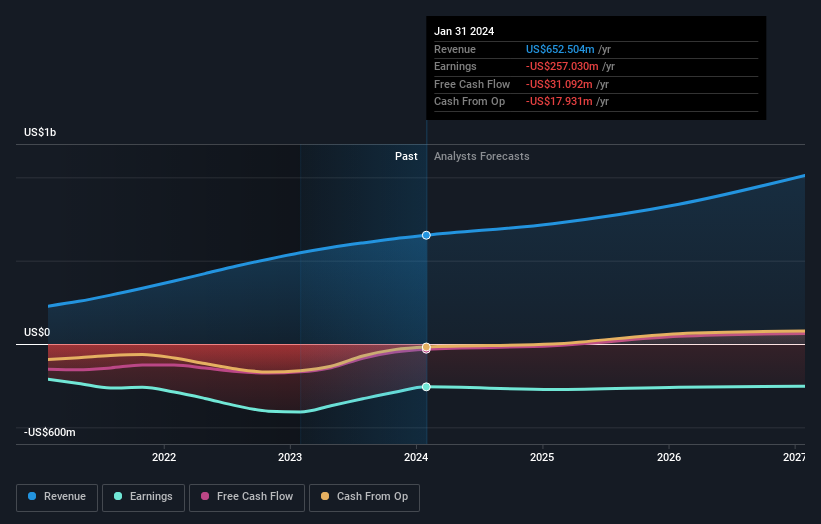- United States
- /
- Software
- /
- NYSE:ASAN
Analysts Have Made A Financial Statement On Asana, Inc.'s (NYSE:ASAN) Full-Year Report
It's been a mediocre week for Asana, Inc. (NYSE:ASAN) shareholders, with the stock dropping 12% to US$16.26 in the week since its latest annual results. Revenue hit US$653m in line with forecasts, although the company reported a statutory loss per share of US$1.17 that was somewhat smaller than the analysts expected. Following the result, the analysts have updated their earnings model, and it would be good to know whether they think there's been a strong change in the company's prospects, or if it's business as usual. So we collected the latest post-earnings statutory consensus estimates to see what could be in store for next year.
See our latest analysis for Asana

Taking into account the latest results, the current consensus from Asana's 18 analysts is for revenues of US$721.8m in 2025. This would reflect a decent 11% increase on its revenue over the past 12 months. Losses are expected to hold steady at around US$1.15. Yet prior to the latest earnings, the analysts had been forecasting revenues of US$716.2m and losses of US$1.24 per share in 2025. It looks like there's been a modest increase in sentiment in the recent updates, with the analysts becoming a bit more optimistic in their predictions for losses per share, even though the revenue numbers were unchanged.
There's been no major changes to the consensus price target of US$20.02, suggesting that reduced loss estimates are not enough to have a long-term positive impact on the stock's valuation. That's not the only conclusion we can draw from this data however, as some investors also like to consider the spread in estimates when evaluating analyst price targets. There are some variant perceptions on Asana, with the most bullish analyst valuing it at US$28.00 and the most bearish at US$10.00 per share. Note the wide gap in analyst price targets? This implies to us that there is a fairly broad range of possible scenarios for the underlying business.
Another way we can view these estimates is in the context of the bigger picture, such as how the forecasts stack up against past performance, and whether forecasts are more or less bullish relative to other companies in the industry. We would highlight that Asana's revenue growth is expected to slow, with the forecast 11% annualised growth rate until the end of 2025 being well below the historical 35% p.a. growth over the last five years. Compare this to the 431 other companies in this industry with analyst coverage, which are forecast to grow their revenue at 12% per year. Factoring in the forecast slowdown in growth, it looks like Asana is forecast to grow at about the same rate as the wider industry.
The Bottom Line
The most obvious conclusion is that the analysts made no changes to their forecasts for a loss next year. They also reconfirmed their revenue estimates, with the company predicted to grow at about the same rate as the wider industry. There was no real change to the consensus price target, suggesting that the intrinsic value of the business has not undergone any major changes with the latest estimates.
With that in mind, we wouldn't be too quick to come to a conclusion on Asana. Long-term earnings power is much more important than next year's profits. At Simply Wall St, we have a full range of analyst estimates for Asana going out to 2027, and you can see them free on our platform here..
That said, it's still necessary to consider the ever-present spectre of investment risk. We've identified 3 warning signs with Asana , and understanding these should be part of your investment process.
New: Manage All Your Stock Portfolios in One Place
We've created the ultimate portfolio companion for stock investors, and it's free.
• Connect an unlimited number of Portfolios and see your total in one currency
• Be alerted to new Warning Signs or Risks via email or mobile
• Track the Fair Value of your stocks
Have feedback on this article? Concerned about the content? Get in touch with us directly. Alternatively, email editorial-team (at) simplywallst.com.
This article by Simply Wall St is general in nature. We provide commentary based on historical data and analyst forecasts only using an unbiased methodology and our articles are not intended to be financial advice. It does not constitute a recommendation to buy or sell any stock, and does not take account of your objectives, or your financial situation. We aim to bring you long-term focused analysis driven by fundamental data. Note that our analysis may not factor in the latest price-sensitive company announcements or qualitative material. Simply Wall St has no position in any stocks mentioned.
About NYSE:ASAN
Asana
Operates a work management software platform for individuals, team leads, and executives in the United States and internationally.
Flawless balance sheet and undervalued.
Similar Companies
Market Insights
Community Narratives



